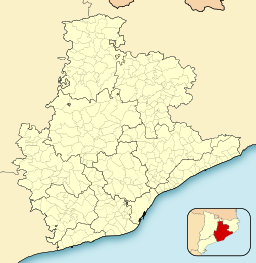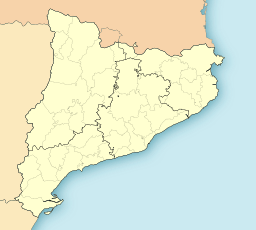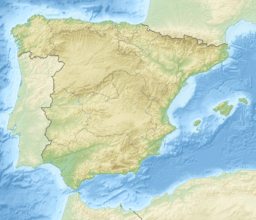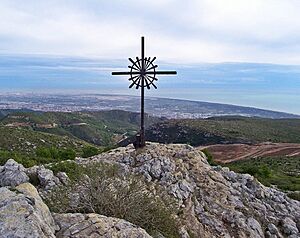Garraf Massif facts for kids
Quick facts for kids Garraf Massif |
|
|---|---|
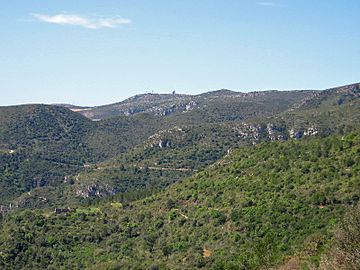 |
|
| Highest point | |
| Elevation | 657.1 m (2,156 ft) |
| Geography | |
| Parent range | Catalan Coastal Range |
| Geology | |
| Mountain type | Karstic |
| Climbing | |
| First ascent | Unknown |
| Easiest route | From Sitges or Castelldefels |
The Garraf Massif is a mountain range found in Catalonia, Spain. It is part of the larger Catalan Coastal Range. This special area is known for its cliffs that drop right into the Mediterranean Sea. The highest point near the coast is La Morella, which stands 593 meters (about 1,945 feet) tall. Further inland, you'll find Montau, which is even taller at 657 meters (about 2,155 feet).
Contents
Where is the Garraf Massif Located?
The Garraf Massif gives its name to the Garraf region and a small seaside village called Garraf. You can find it south of Barcelona, nestled between the coastal towns of Castelldefels and Sitges. Major roads like the C-31 and C-32 run along its coastline. The RENFE Barcelona-Valencia railway line also passes through this area.
In the middle of the massif, you'll find the small town of Olivella. There's also Plana Novella, which is home to a peaceful Buddhist monastery. The abandoned village of Jafra is also located within the Garraf Natural Park.
What is the Garraf Massif Like?
This mountain range is mostly made of calcareous rock, which is a type of rock rich in calcium carbonate, like limestone. Because of this, it doesn't have many dense forests. Instead, you'll see many rocky, open areas. The main plants here are maquis shrubland, which are tough, bushy plants that can survive in dry conditions. A special plant called the Mediterranean Fan Palm grows naturally in these mountains.
The Garraf Massif is famous for its "karstic" features. This means the limestone rock has been shaped by water over time, creating more than 400 shafts (deep, narrow holes) and caves. One of the largest is La Falconera, a huge cave that even has an underground lake.
Protecting the Garraf Massif Environment
The Catalan Government has declared the Garraf Massif a Protected Area. This means it's a special place that needs to be looked after. However, some parts of the massif have faced challenges. For example, there are quarries where rock is dug out, and large rubbish dumps (landfills) that can affect the mountains. These activities can sometimes pollute the underground lakes and rivers that are part of the karstic system.

In some areas, especially near Sitges and Castelldefels, new buildings have been constructed. These include many bungalows and small houses, particularly along the seafront.
See also
 In Spanish: Macizo del Garraf para niños
In Spanish: Macizo del Garraf para niños
- Garraf, a seaside village
- Vallcarca, a large limestone quarry complex
- Olèrdola
- Plana Novella
- Catalan Coastal Range
- Mountains of Catalonia


